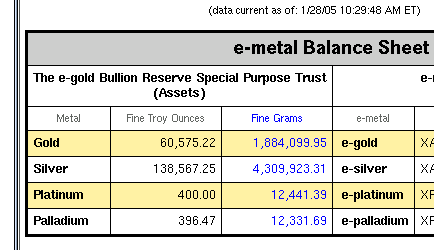January 28, 2005
OSGold's bank to be sued - should have used 5PM
Everyone knew that OSGold was "probably a fraud." Now, writes Declan McCullogh their bank is being sued, and Judge Kaplan has said that the actions of the bank " tend to show conscious disregard or recklessness and give rise to a strong inference of fraudulent intent." The case moves forward, he says, with a headline number of $250 million.
The reason the gold community knew in advance was a little thing called the 5PM. In the five parties model, we set up a ring of 5 players who all work together to guard the assets. The Issuer (OSGold in this case) issues the instructions, the Co-signatory would sign off on metal going out, the Repository would hold the metal. An internal Manager would deal with the grunt work of moving the bars in and out.
The fifth party is the User. The owner of the value, she is charged with watching and checking. In order to fill her insatiable appetite for auditing information, the Issuer publishes reports on a frequent basis. By way of example, let us now do our duty as users in the 5PM and have a look at e-gold's Examiner. Today, e-gold claims that there is 1844kg of gold, 4310kg of silver, 12.4kg of Platinum and 12.3kg of Palladium in their vaults.

Fig 1. Snippet from Examiner: e-gold's reserves
Tomorrow it will say the same thing, more or less. Yesterday, ditto. That means if these numbers aren't correct, then the Issuer is defrauding the public. It's plain and simple. If that gold and platinum and silver and whatnot is not there in the vaults, and those pages say the metal is there, it's bona fide fraud, open and shut case.

Fig 2. Snippet from Examiner: e-gold's statement
This Issuer has gone out and put his word on the line. The reason we knew that OSGold was a probably fraudulent was because OSGold never ever said anything about their reserves. Nothing one could pin down, at least. OSGold did not put their honour, their livelihood and their good name on the line. It was therefore ... worthless.
Goldmoney go one better and one worse than e-gold. Their report shows information quarterly only which in this business is enough time to do serious damage. But they do arrange for the reports from the repository itself to be issued, which is much more credible than e-gold's claims-by-self.
I apologise for the PDF and the size of the snippet below, but again, I urge you to do your 5PM duty and check out that document. The debate rumbles on as to whether the claims of independent parties and the issuer are better or worse. My answer is simple: give me both. Because I want to lock you down both ways in case of fraud.
In OSGold's case, there was no locking down to be done, and the metal probably never existed anyway. If the bank concerned was just plain duped, then I'll bet they'll rue they day they didn't pay attention to the 5PM.

Fig 3. Snippet from Repository's bar report for Goldmoney
Ian,
>> The reason we knew that OSGold was a probably fraudulent was
>> because OSGold never ever said anything about their reserves.
Not true. Reed said they had 150% reserves: 50% each of bullion, gold bonds and dollars. Their claims were so confused and absurd that anyone who didn't already know they were fraudulent had reason to know when they said that.
Best,
Posted by: CCS at January 28, 2005 11:54 AMThis mail makes one major erroneous assumption. It says:
| This Issuer has gone out and put his word on the line. The reason we
| knew that OSGold was a probably fraudulent was because OSGold never
| ever said anything about their reserves. Nothing one could pin down,
| at least. OSGold did not put their honour, their livelihood and their
| good name on the line. It was therefore ... worthless.
The qualities named are honor, livelihood & good name. For fraudulent
organizations, honor & good name mean nothing--they are abstract
qualities striven towards by, well, fraudulent means. The "livelihood"
does not fit into that grouping, as it is directly derived from the rest
(i.e. a frautulent organization being what it is, is not concerned about
maintaining the reputation--key word there--required to maintain a
trusting and loyal clientele or supply chain.)
You thus cannot group the three, because it implicitly assumes that they
are equal-value concerns of any commercial entity when, in fact, (a) one
is derived from the other two for legit companies, and (b) illegit
companies don't, frankly, give a rat's ass about (1) and (3), counting
on a quick-in-and-out underlined by fraudulent representations of (1)
and (3) to take care of (2).
Cheers,
- -John
Posted by: JMS at January 28, 2005 06:40 PMThe real reason you can tell this was a fraud is because all "high yield investment programs" (HYIPs) are frauds. They are Ponzi and pyramid schemes. In this case, OSGold promised GUARANTEED MONTHLY RETURNS of 30 to 45 percent. That's all you need to know! It has nothing to do with whether they conjure up a web page with some imaginary values on it of their supposed holdings. How could that possibly prove anything? It's not audited!
Posted by: Cypherpunk at January 31, 2005 01:59 PMCypherpunk,
are you sure on that point? Weren't there two operations, being the OSGold issuer and the OSOps HYIP? Being run by the same people but clearly intermingled?
iang
Posted by: Iang at January 31, 2005 02:13 PM